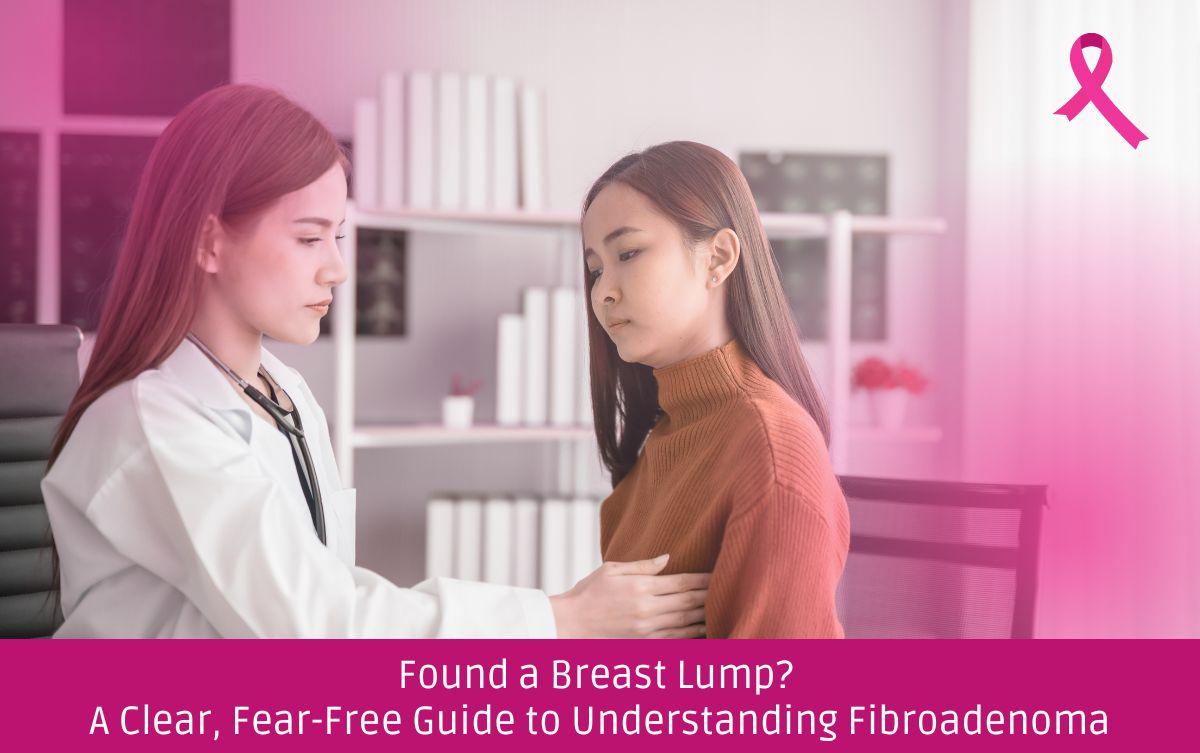If you’re a woman living in Delhi NCR and you’ve recently felt a lump in your breast, the first emotion is usually fear. Your mind jumps straight to one word: “cancer”. And then Google or AI becomes the first doctor you consult at midnight. Most women search for things like:
“Is fibroadenoma dangerous?”
“Can fibroadenoma turn into cancer?”
“Should I remove my fibroadenoma or leave it?”
“Why do I always get lumps?”
“Does diet cause fibroadenoma? Which hormones are responsible?”
If this sounds like you, you’re not alone. Fibroadenoma is one of the most common breast lumps in young women, especially between the ages of 15 and 35. And the good news? It is completely benign. But that doesn’t mean you shouldn’t take it seriously.
Dr. Rohan Khandelwal, a breast oncologist in Delhi NCR, explains fibroadenoma in a way that removes fear while giving clarity.
What Exactly Is a Fibroadenoma?
Here is a simple Explanation Without Medical Jargon. A fibroadenoma lump is basically a non-cancerous overgrowth of breast tissue. Think of it as a small bundle of cells that decided to grow together, forming a lump.
Here is what it might feel like in real life inside a breast;
✔ Smooth
✔ Mobile (moves under the skin; this is a classic sign)
✔ Painless
✔ Round or oval
✔ Firm but not rock-hard
Women often describe it as a “marble-like lump” or a “button in the breast.”
It does NOT spread, it does NOT invade, and it rarely turns cancerous.
Why Do Women in Their 20s & 30s Get Fibroadenomas?
Most patients ask, “Doctor, maine kya galat khaya?” The answer: Nothing.
Breast Fibroadenomas are usually triggered by hormonal fluctuations, especially estrogen. That is why they appear more in:
✔Teenagers✔Young women
✔Women who are pregnant
✔Women on birth-control pills
Stress, diet, and exercise, none of these truly “cause” fibroadenomas.
Types of Fibroadenoma
Most women don’t know this, but must educate themselves on the types of fibrodenoma. Not all fibroadenomas are the same. Here are the different types of fibroadenoma that can occur in a woman;
✔ Simple Fibroadenoma
The most common type. Small, stable, harmless.
✔ Complex Fibroadenoma
Has additional features under a microscope. Still benign but needs monitoring.
✔ Giant Fibroadenoma
Larger than 5 cm. May require removal due to size.
✔ Juvenile Fibroadenoma
Seen in girls under 18. Grows faster due to hormonal surges.
How Do I Know If My Lump Is a Fibroadenoma or Cancer?
This is the biggest fear.
Here’s the honest truth:
You cannot differentiate by touch. Even experienced doctors do not rely only on touch.
The only reliable diagnostic steps are:
✔ Breast Ultrasound- This is best for women under 40✔ FNAC (Fine Needle Aspiration Cytology)- It includes taking a few cells to examine the lump
✔ Core Needle Biopsy- Here doctor takes a small tissue sample to examine the fibroadenoma.
In Delhi NCR, most breast oncologists prefer Ultrasound + Core Biopsy for accurate diagnosis.
Should I Remove My Fibroadenoma or Not?
This is the most common question worldwide searched by women.
You usually DO NOT need surgery if:
✔The lump is <3 cm
✔It does not grow
✔It is confirmed benign on biopsy
✔It doesn’t cause pain
You should consider REMOVAL if:
✔The fibroadenoma grows rapidly
✔It becomes painful
✔It is >3–4 cm
✔The biopsy shows a “complex” pattern
✔Your family has a history of breast cancer
✔You feel anxious keeping it inside
As breast oncologists, we always tell women:
“Your peace of mind matters as much as the medical decision.”
Does a Fibroadenoma Turn Into Breast Cancer?
Extremely rare. Less than 0.3–0.5% cases show malignant transformation. In simple words: 99.5% chance it will NEVER turn cancerous.
Should I worry if I have Fibroadenoma during Pregnancy ?
During pregnancy, because of high hormones:
Fibroadenomas can temporarily increase in size
Some women feel more tenderness
post-delivery, they often shrink
Only in large or painful cases do we remove them during pregnancy.
Does Diet Affect Fibroadenoma?
Women constantly ask:
“Should I stop coffee?”
“Does dairy increase lumps?”
“Is chicken harmful?”
Scientific truth:
Food does not cause fibroadenomas. But caffeine may worsen breast pain, not the lump itself.
Modern Painless Treatment Options (Delhi NCR)
Earlier, surgery meant a visible scar. But now we have scar-minimizing techniques:
Vacuum-Assisted Excision (VAE)
✔ No stitches
✔ 10–20 minutes
✔ No hospital stay
✔ Minimal scarring
Endoscopic/Minimal Incision Surgery
For larger lumps.
Simple Surgical Removal
Still used when lumps are big.
How Often Should You Follow Up?
If your fibroadenoma is not removed, follow:
Every 6 months for the first year
Once a year thereafter
This is to ensure it stays the same size.
Frequently Asked Questions
Usually no. But during periods or hormonal fluctuations, slight discomfort is normal.
No. There is no such proven scientific evidence that doing exercise can cause lumps.
Small ones sometimes shrink. Not always.
Absolutely yes.
Mostly not. It’s done under local anesthesia.
No, but stress increases awareness and sensitivity.
Fibroadenoma is common, harmless, and manageable. The key is proper diagnosis, routine monitoring, and choosing the right breast oncologist in Delhi NCR who understands both the medical and emotional concerns women face.













